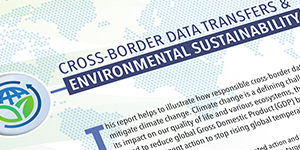
Some of the most powerful tools for combating climate change—carbon emissions tracking, predictive climate modeling, and less energy-intensive computing resources—depend on the ability to freely access cross-border data transfers. By contrast, restricting the ability to share knowledge, information, and data across transnational IT networks, and mandating the localization of computing resources in particular regions undermines the ability to address climate challenges and in many cases can risk having the opposite effect of reducing emissions.
- Data Transfers & Carbon Tracking
Addressing climate change requires assessing the carbon profiles associated with organizations, processes, and product and service offerings. Achieving these assessments are critical to meaningful emissions and carbon tracking and depends upon gathering a wide array of data points from across regions and organizations—which means access to cross-border data transfers.
This includes data gathered across transnational digital networks—transportation logs, meter readings, fuel purchase records, direct monitoring, or other methods for acquiring data from specific activities across the international value chain. In this context, data analytics combined with Internet of Things (IoT) solutions can help enterprises more efficiently structure, collect, and transform cross-border data into reports for accurate carbon accounting, reducing overall efforts around data collection and enhancing data quality.
- Data Transfers & Predictive Climate Modeling
Cross-border data transfers are also critical to predictive climate modeling, an emerging area of environmental data science focused on predicting a wide array of climate risks and their collateral impacts—such as property damage and supply chain disruptions. Predictive climate modeling allows for improved disaster planning and recovery as well as better predictions of actuarial risks relating to climate change.
Cross-border predictive climate modeling requires the real-time application of machine learning and traditional weather modeling approaches to multi-regional data, which may include satellite data, sensor data from weather stations, topographical data, and IoT data. This type of modeling helps disaster risk experts from national and international organizations better prepare communities for climate-related risk. Likewise, cloud-based digital twins solutions are being used to predictively model future climate changes by aggregating large volumes of cross-border data relating to atmospheric and topographical conditions as well as human activities.

